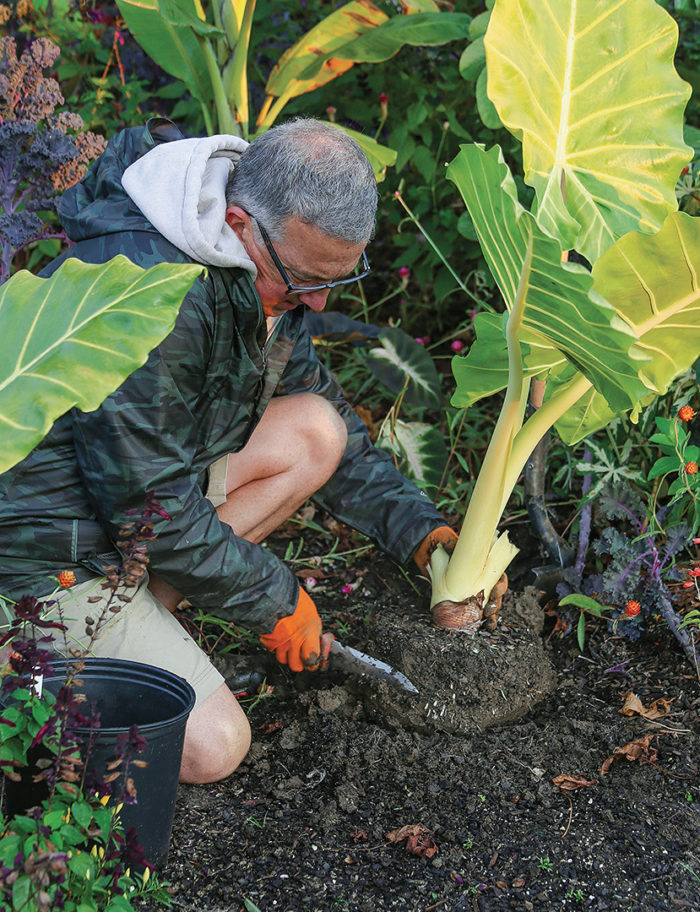
Tropical plants are a major part of my home garden. It requires effort to lift them every fall and replant them in spring, but it’s worth it to have a taste of the tropics here in the land of cornfields. Since I do not have a greenhouse, all of my tropicals must either tolerate life as houseplants or go dormant to make it through the winter.
Some questions need to be asked as the frosts of fall approach: What gets dug up? Do I save all the cannas, or just the ones that are hard to find? What can handle a frost? The more frost tolerant a plant is, the later it gets dug up.
To help you decide which plants to save, consider rarity, sentimental attachment, and, of course, beauty. If you question whether you can find it again, or it is pricey, try to save it. You’ll also want to save the dahlia Aunt Clarice gave you right before she had to give up gardening. She can’t give you another, and it’s not the same to buy a new one online. And if you really love a plant, try to keep it. With a bit of luck it will grow larger next year; as a bonus, you may be able to divide it.
Once you decide to save a plant, you then have to decide how to overwinter it. Does it need to be kept growing, or can it be allowed to go dormant? I’ll provide some ideas of how to do both.
None of the overwintering methods covered here come with a guarantee that every plant will survive every winter. Think of this as an experiment, and try to be OK with the idea that some plants will die. I tell plants two things when they come in for the winter: “Live or die, it’s your choice,” and “If you die, I can replace you with something newer and prettier.” In reality I may not be so carefree, but the plants don’t need to know that. Here are my tips for giving your plants the best chance at survival.
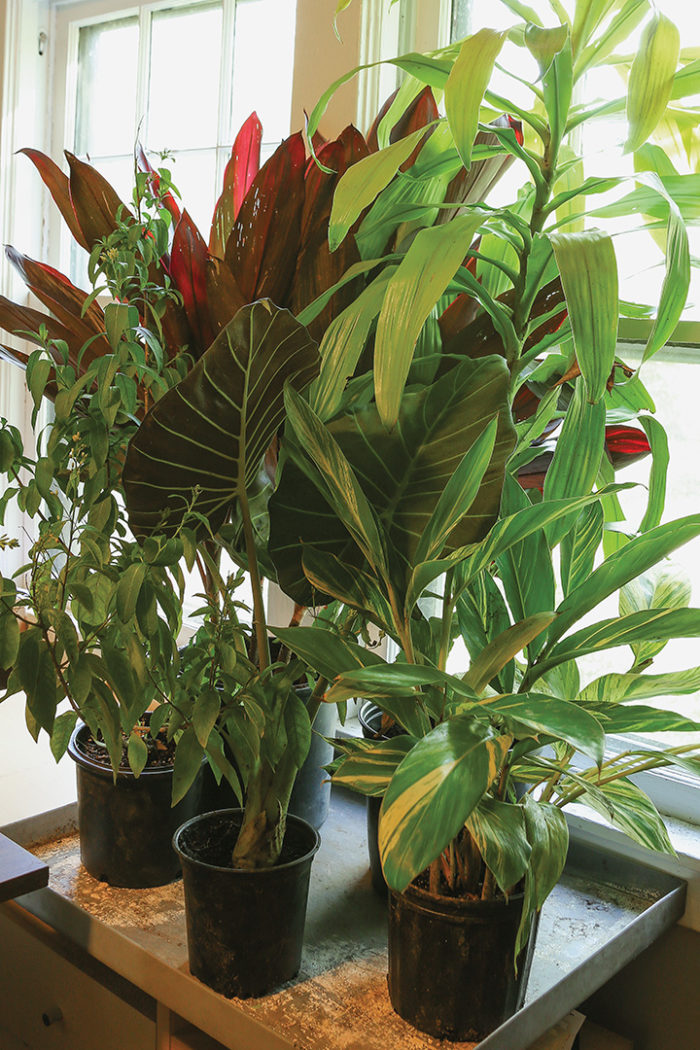
Keeping a plant growing is your surest bet
Some tropical plants are damaged at 40°F, and a hard frost might kill them. These should be the first ones dug up in autumn, and they will need to be kept growing indoors to survive winter. Like most people, I can’t provide perfect growing conditions for the plants I bring inside. A plant that prefers a south window may have to endure a north window. Nobody will be getting tropical temperatures, so my home’s typical winter temperatures must suffice. I do not try for perfect plants; my goal is for them to survive. If you wish to strive for better, you have my blessing.
Basic prep
- Simply dig up the plants you want to save, and pot them using barely moist soil. Take only as much root ball as necessary, and prune back the top as needed to fit your available space.
- Check weekly to see if the plants need water. Avoid overwatering, as overly wet soil will cause rot.
Plants this works best for
This method works for a host of plants too numerous to list. If you’re not sure a plant can go dormant during the winter, try turning it into a temporary houseplant. Here are a few examples:
- Philodendrons (Philodendron spp. and cvs., Zones 11–14)
- Dracaenas (Dracaena spp. and cvs., Zones 11–15)
- Cordylines (Cordyline spp. and cvs., Zones 9–11)
- Agaves (Agave spp. and cvs., Zones 9–15)
- Mangaves (Mangave cvs., Zones 9–11)
- Begonias (Begonia spp. and cvs., Zones 12–13)
 |
 |
 |
Dormant plants are easy to care for and take up less space
I actually prefer tropicals that can go dormant over the winter. These plants can be stored in a cool, dark place; the main thing is to keep them from freezing. Once they are put away, you can essentially ignore them until spring. However, it is a good idea to check your plants at least once a month and to give them a small amount of water if they are bone dry. If a plant is stored in an open plastic bag, the monthly check also offers a chance to open that bag wider if the plant is too wet. If some plants push growth when they are supposed to be dormant, don’t worry about it. This is normal, since we cannot provide the ideal temperature and moisture conditions for perfect dormancy. Think of it as having a jump-start on spring.
Before digging up plants that will be stored dormant, allow them to be hit by frost at least once; this will help to ease them into their dormant state. Then remove all remaining foliage, and most of the soil from their roots, regardless of how they will be stored.
Basic prep for dormant storage
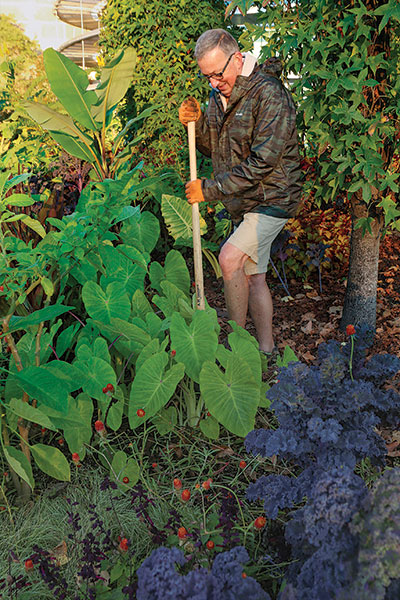 |
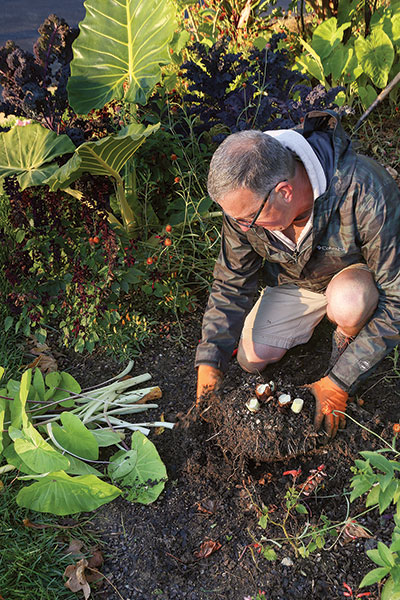 |
 |
| Dig up plants late in the season. The best time to dig is after the first frost. Get as much of the root ball as you can, and try not to damage the crown. | Cut off all leaves. Trim stems to about ½ to ¾ inch above the soil line. For plants like bananas with large trunklike stems, trim the leaves back to the stem. | Remove most of the soil from the roots. It isn’t necessary to clean off every last bit of soil, just enough to make the root ball compact and easy to handle. |
Method 1: Store fleshy roots in wood shavings
The rhizomes or tubers of some plants can be stored in wood shavings. This method takes up very little space and is a good solution for plants with fleshy, durable roots. Allow the roots to dry for a few days before storing.
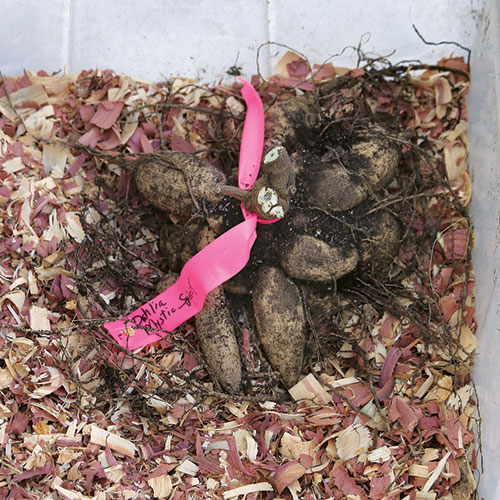 |
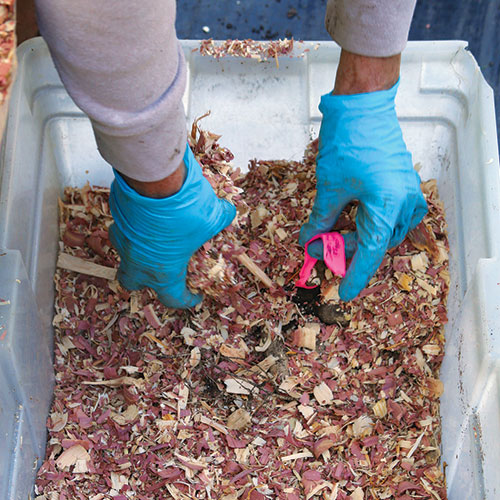 |
| Use a plastic storage tote. Line the bottom with a layer of wood shavings, sold as animal bedding at pet stores and farm supply stores. Add a layer of roots, spaced so they are not touching. | Top with more shavings. Do not put the lid of the container on, as this will trap moisture and cause rot. Cardboard boxes or nursery pots can also be used for this type of storage. |
Plants this works best for
- Cannas (Canna spp. and cvs., Zones 8–11)
- Dahlias (Dahlia spp. and cvs., Zones 8–11)
- Caladiums (Caladium spp. and cvs., Zones 9–11)
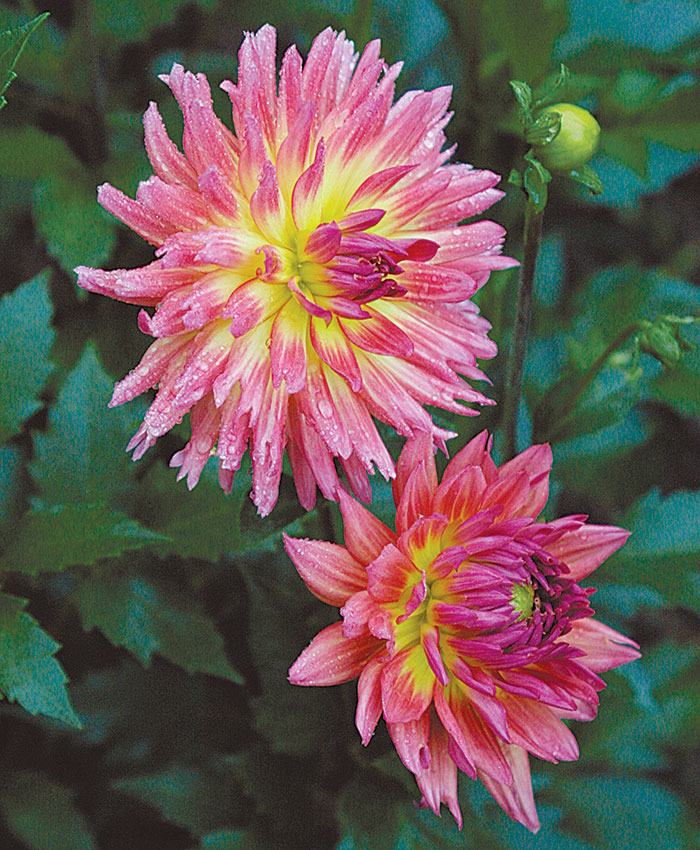
Method 2: Cut back the top and pot it up
I like to pot up certain plants. Compared to bagging, this method can give smaller plants a better chance at surviving dormancy. However, this method is a bit more time consuming, and the plants will be heavier and harder to move.
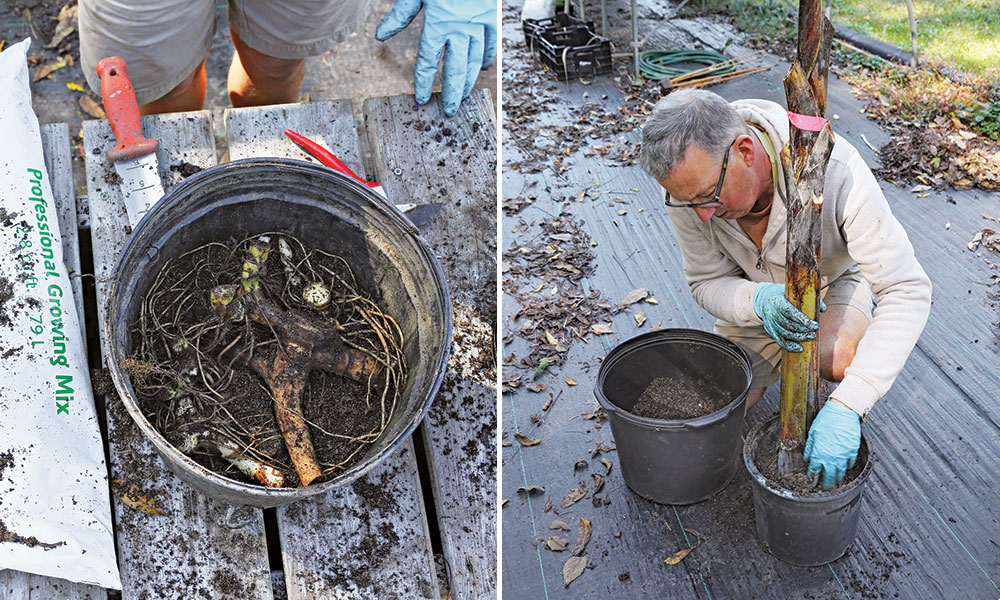 |
| Pot them up and keep them cool. After removing most of the soil, place the root ball in a pot just big enough to hold it. Add enough slightly moist potting soil to cover the roots. Then store in a cool, dark place. Check the plants monthly while they are in storage; angels’ trumpets are the most likely to need water occasionally through winter. |
Plants this works best for
- Angels’ trumpets (Brugmansia spp. and cvs., Zones 9–11)
- Small bananas (Musa spp. and cvs., Zones 8–11, Musella lasiocarpa, Zones 8–11, Ensete spp., Zones 9–11)
- Alocasias (Alocasia cvs., Zones 10–11)
- ‘Stuttgart’ canna (Canna ‘Stuttgart’, Zones 8–11)
- Canna rhizomes (Canna spp. and cvs., Zones 8–11) that you’d like to give a better chance at survival
- Xanthosomas (Xanthosoma cvs., Zones 10–11)
 |
 |
 |
Method 3: Store them in plastic bags
I have a lot of plants to store and limited space, so my go-to method for many plants is to drop them into plastic bags and store them in a cool, dark spot.
Certain larger plants I simply prepare as if I were potting them up, then I drop them into open plastic bags. I allow other plants to dry for about a week, after which I store them in tied plastic bags.

By experimenting over the years, I have discovered that many plants are less demanding than I thought. For example, my colocasia have had a 100% survival rate when stored in tied plastic bags.
Tip: Don’t forget to label! You think that you’ll remember, but trust me, you will forget everything by next spring. Use flagging tape (sold in home centers and hardware stores) and a permanent marker to create labels that can be tied easily onto individual plants.
Open plastic bags
 |
 |
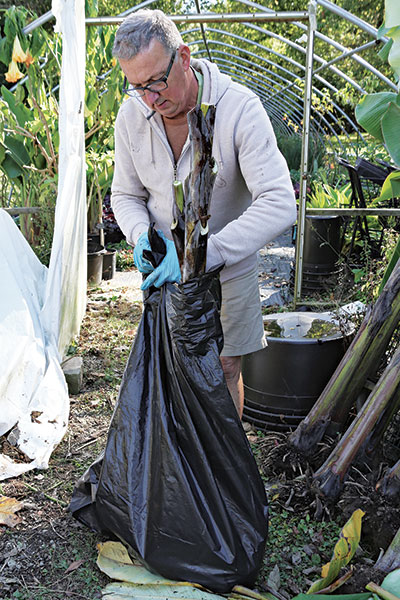 |
| Certain plants are best stored in open plastic bags. For bananas and similar plants with large, trunklike stems, cut the leaves back to the stem and remove most of the soil from the roots. | Tip each plant upside down. This removes water held in the leaf sheaths. You may be surprised by how much water comes out! This is an important step, since all that extra water can cause rot. | Loosely gather the top edge of the bag. Tie the bag shut, leaving enough of an opening to allow excess moisture to evaporate. Check the bag monthly while it is in storage, and adjust the opening size if the plant seems too wet or too dry. |
Open plastic bags work best for
- Large bananas (Musa spp. and cvs., Zones 8–11, Musella lasiocarpa, Zones 8–11, Ensete spp., Zones 9–11)
- Large canna clumps (Canna spp. and cvs., Zones 8–11)
- Large alocasias (Alocasia cvs., Zones 10–11)
- Ginger lilies (Hedychium spp. and cvs., Zones 7–11)
- Setcreasas (Tradescantia pallida ‘Purpurea’, Zones 8–11)
 |
 |
 |
Tied plastic bags
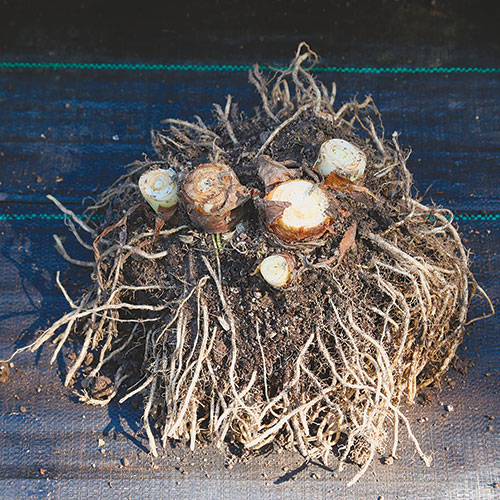 |
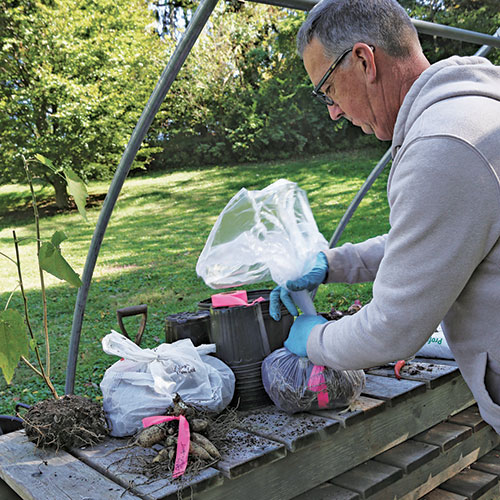 |
| Plants that will be stored in closed plastic bags should be allowed to dry out for about a week. Too much moisture encourages decay, so be sure your plants are good and dry before tying the bags shut.
|
Give each plant its own bag. Lightweight plastic shopping bags or trash bags work well. Label each plant, place it in a bag, and tie the top closed. |

Tied plastic bags work best for
- Colocasias (Colocasia spp. and cvs., Zones 8–11)
- Flowering maples (Abutilon spp. and cvs., Zones 8–11)
- Lantanas (Lantana spp. and cvs., Zones 9–11)
- Zonal geraniums (Pelargonium spp. and cvs., Zones 12–13)
Irvin Etienne is the horticultural display coordinator at Newfields in Indianapolis.

















Comments
Thanks for the interesting tips! Can I leave my favorite potted Flowering maple (Abutilon "Victorian Lady") outside in a sheltered spot next to my house in California Zone 9b, or will it die? It has been doing very well in my side yard planted in a large pot all summer and fall, but it can get around 25°F a few times here in the winter. Do you have any recommendations for leaving it outside in the same spot, but sheltering it from the cold and the wind a little?
Log in or create an account to post a comment.
Sign up Log in